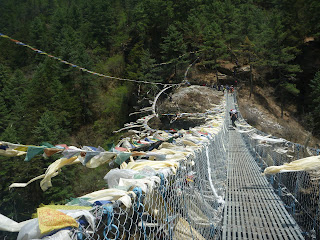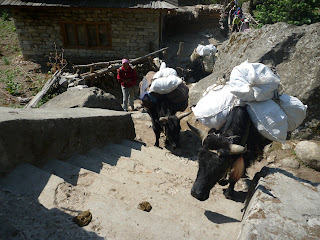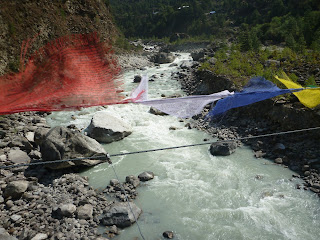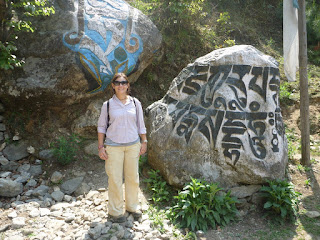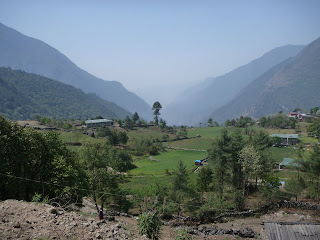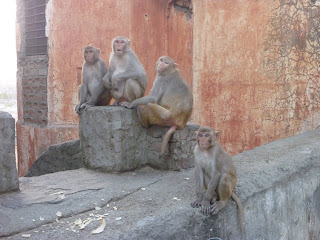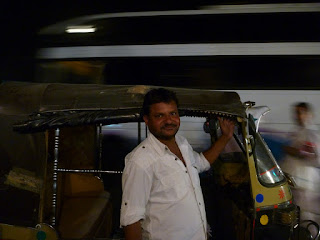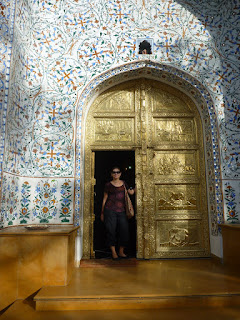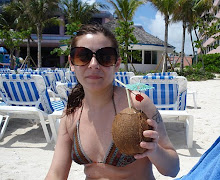



April 28, 2010
Rest day, Namche Bazaar
The Everest Base Camp trek is relatively well mapped out. Most everyone flies to Lukla, spends a night in Phakding, then moves onto Namche Bazaar for two nights. Because of the extreme gain in elevation, it is essential to spend an extra day acclimitizing in Namche. People who are sensitive to the altitude usually start to exhibit signs of distress at around 3500 meters. Symptoms start with a headache, dizzy spells, nausea, unsound sleep and, if ignored, can progress rapidly to Acute Mountain Sickness. AMS is a life threatening disorder brought on by not giving the body enough time to adjust to the lack of oxygen in the air. HAPE (high altitude pulmonary edema) and the more serious HACE (high altitude cerebral edema), mostly affecting climbers at higher altitudes than I'd be going, can be fatal. The only cure is to go down, period. Hence, the treks are arranged with acclimitization days built in. It's often times the strongest and fittest people who don't allow time to acclimitize and ignore early signs of AMS (such as a headache) that run into trouble higher up. I was feeling okay, but was exhausted from the grueling day before. I was thrilled to have a “rest” day.
Of course, a Nepali rest day is not a rest day at all. Instead, we'd be doing some more trekking. The motto up here is “climb high, sleep low.” Climbing higher, even a few hundred feet, then descending to sleep at a lower altitude helps the body adjust. I knew the walk would be good for me, even though I was very sore. After breakfast at 7AM (no sleeping in here, even on a rest day) we embarked on another uphill climb to the Everest View Hotel. This hotel, supposedly the highest luxury hotel in the world, was built by the Japanese. Rooms are expensive at a couple hundred bucks a night, and it's rarely full. Trekkers certainly are not staying there. I assume the hotel makes its money by the tourists who chopper in for the day (there's a tiny airstrip about a 90 minute hike from the hotel and it might even have its own helipad on top), have lunch, and split before the altitude makes them sick. Phurba told me there was a sitting area where we could take tea and see the mountain. I was excited for this and hoped the weather held.
The day before, after spending an hour at the lodge resting in Namche, and once I was sure my legs would let me stand on them again, I asked Phurba to help me find some trekking poles. During the brutal climb, I had serious thoughts about knocking one incredibly rude German woman off the mountain and stealing her poles. Luckily, Namche is a trekker's outpost. The stuff is mostly overpriced knockoffs, but I did not care. Phurba talked the vendor down to a respectable(ish) price and I hoped my purchase would lend some extra support to my aching limbs. It did. Namche Bazaar is a crescent shaped settlement nestled into the steep curve of a mountainside. It looks a lot like terraced rice paddies, except the terracing holds stone buildings. The entire town is a system of stone steps. And so we left the guest house and immediately started ascending up through Namche. The trekking poles didn't make my agony disappear, but they definitely helped. We got through the town, climbed over a boulder/wall and the trail presented itself. It was a vertical zigzag to the top, and it hurt. When I looked down to see just how steep this climb was, I realized how steep the town of Namche itself is. I've no idea how those buildings were even built, let alone how they don't topple over.
After an hour of tough climbing (think 2 or 3 thousand giant stone steps) we reached a wide open plateau. The trail was visible for miles, a little brown path cutting through the mossy clearing that wound around the side of the mountain and disappeared, only to reappear far off in the distance, on the other side of a gorge. The weather was perfect for the time being with clear blue skies giving me my first glimpse of some really high peaks. To the west was the omnipresent Kongde Ri (6187m) and the holy and unclimbed Khumbila (5761m). They were absolutely giant, covered in snow and ice many thousands of meters up, towering over the shrub covered meadow we were walking through. It was as scenic a place as I'd ever seen. That is, until we turned a bend and the meadow ended. The path hugged the mountain and the first thing I noticed was the gorge you'd plunge to your death in if you took a wrong step. The second thing I noticed was an extremely rude group of French trekkers literally (and dangerously) running down the trail. Nobody runs at this altitude and I started to curse them under my breath, when I noticed the third thing. Behind them, about a 7 day walk away, towering up above the majestic and vast Solkhumbu range, was Mount Everest (8848 m), with its unmistakable plume of “smoke” (there's always a cloud formation blowing around up there) wafting off its angled peak. Right next to it was the mammoth Lhotse (8501m), and closer to us was the utterly recognizable Ama Dablam (6856m) sticking out like a sore thumb. Tawoche (6542m), Kang Taiga (6685m) and I think Chhukhung (5833m) and Thamserku (6808m) rounded out the view. Pink, white and red blossoms of the rhododendron forest peppered the deep valley separating me from the gigantic peaks, and the place where I was standing pretty much marked the end of the evergreens. Higher up was only shrub, then rock, then snow and ice. This was the single most scenic thing I have ever seen. Every agonizing step I'd taken to get there was worth it, and the pain and shortness of breath disappeared for awhile. We walked on further to the lodge, all the while feeling like I was in a dream (or the Sound of Music, or Lord of the Rings) in utter awe of the landscape. I was in disbelief that I was actually seeing the single biggest thing on the planet with my own eyes. The sheer magnitude of the place was heavy; few people ever get to look upon the Himalayas outside of a book and now I was one of them. We had tea (and paid New York City prices for a pot) and I took about a hundred photos. I made sure to linger for as long as possible, and only started the walk back to Namche when the afternoon weather began to cloud Everest and Lhotse from view. I hoped no climbers were up there, and turned to leave.
I discovered during the climb down the rocky and hazardous path that I'm not too good on the descent. Out of nowhere, my right knee started to hurt (and would continue to do so until I got back to Kathmandu), which made the going pretty slow. There was a lot of scree (loose small rocks and pebbles) on the trail which makes sliding and falling a real concern. I've already got one scar in the middle of my face; I'm not trying to get another one. I was obsessively cautious of my footing. On this stretch of the trek in particular, vertigo became an issue for me because we were in a clearing, so our destination far below was visible, as were the thousand places you could fall into and break your neck. I was also starving and Phurba, who, like all Sherpas, is like a spider on these hills, skipping along in flip flops, was far ahead with my bag - which had snacks. It was difficult and I had to let a lot of people pass me by.
We had to go to the Sherpa museums (yes, 2 of them) before going back to the lodge. I had agreed to do this before I knew how deflated I'd be by noon (which is when my body was used to eating lunch). To tell Phurba I didn't want to go would have been bad; I didn't want to insult his heritage. He really wanted to show me both of these museums. They were interesting enough, but my head was starting to pound and they were not exactly next to each other, which meant more walking. My interest was waning, as was the Mt. Everest afterglow. I was feeling weak and just as we were on the outskirts of Namche, I slipped on some scree and fell down a few steps. I used the pole to break my fall, which thankfully wasn't that hard. Phurba was getting on my nerves and his nonchalant, “careful, please” response didn't help matters. I snapped at him that it was 2pm and about time he got me fed. He produced some cookies and didn't talk to me until later.
I wanted to collapse into a giant white bed with lofty down covers and watch reruns of the Simpsons. No such luxuries existed at the Khumbu Lodge, where the main dining room was warm and cozy but the rooms were like sleeping in a barn. When we finally got back there, I was in no better shape than the day before. Phurba forced me to drink a liter of boiling water (his cure for everything), which actually worked to get rid of my headache (if only it did the same at sea level). I had some food and asked the owner where the shower was. He charged me about 5 dollars, then led me to a padlocked room. The clouds had moved in and the air temperature was probably around 30 degrees. After three days of trekking, I badly needed a shower, but could not put my body through the shock of plunging under ten degree water. I was relieved to see an actual heater, and though the pressure wasn't great, the water was steaming. It was the last hot shower I'd have until I got back to Kathmandu, and was certainly a luxury.
I spent the evening hoping my hair would dry and talking to a guy from Norway who had been stuck at the lodge for a week with pneumonia. He had some dried snot in his beard and a curious gurgle in his voice. I wasn't sure whether he was hitting on me or just making conversation, but I wasn't sticking around to find out. Getting sick up here would be crippling. I finished my dahl baat (lentils, rice, vegetables – a Nepali staple), highly recommended the shower to him and retired to my sleeping bag. I bundled up in my nighttime gear of hat, headlamp, fleece pants and slippers and quickly passed out into a deep, dreamless sleep.



